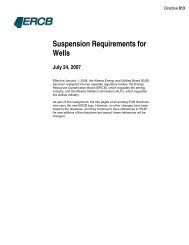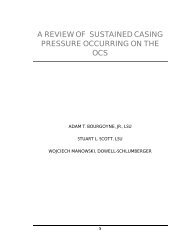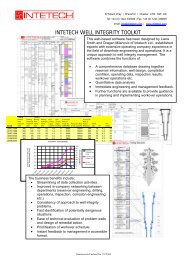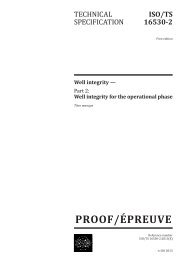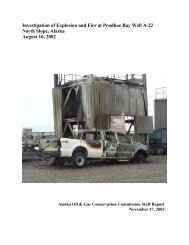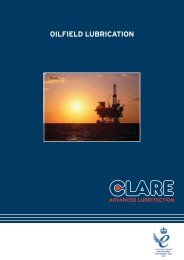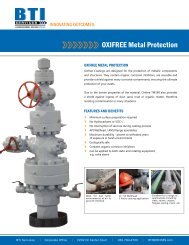Report Investigation of gas blowout on Snorre A - Well Integrity ...
Report Investigation of gas blowout on Snorre A - Well Integrity ...
Report Investigation of gas blowout on Snorre A - Well Integrity ...
Create successful ePaper yourself
Turn your PDF publications into a flip-book with our unique Google optimized e-Paper software.
On SNA, pers<strong>on</strong>nel were aware at an early stage that a <str<strong>on</strong>g>gas</str<strong>on</strong>g> <str<strong>on</strong>g>blowout</str<strong>on</strong>g> from the seabed could<br />
c<strong>on</strong>stitute a danger <str<strong>on</strong>g>of</str<strong>on</strong>g> loss <str<strong>on</strong>g>of</str<strong>on</strong>g> buoyancy and stability. 17 Therefore, a CCR operator was<br />
assigned to c<strong>on</strong>tinuously m<strong>on</strong>itor the tensile force in each leg. No changes were recorded in<br />
the tensi<strong>on</strong> <str<strong>on</strong>g>of</str<strong>on</strong>g> the legs during the course <str<strong>on</strong>g>of</str<strong>on</strong>g> the incident.<br />
After 2125 hours 18 , the drilling module was also running <strong>on</strong> emergency power. The well<br />
c<strong>on</strong>trol work was less effective due to significantly reduced power supply to the drawworks,<br />
rotati<strong>on</strong> <str<strong>on</strong>g>of</str<strong>on</strong>g> the work string and mud pumps. Up until midnight, they did not achieve pump<br />
rates that were sufficient to <str<strong>on</strong>g>of</str<strong>on</strong>g>fset the influx.<br />
During this phase, several alternative soluti<strong>on</strong>s were discussed for regaining c<strong>on</strong>trol over the<br />
well, including full cementing. The cement pumps run <strong>on</strong> diesel motors and thus do not rely<br />
<strong>on</strong> the main power. Because the engine and cementing rooms take in air from the underside<br />
<str<strong>on</strong>g>of</str<strong>on</strong>g> the facility, this c<strong>on</strong>stituted a danger with regard to <str<strong>on</strong>g>gas</str<strong>on</strong>g> being sucked in, and they could<br />
therefore not be used. Measures were implemented to turn the air intake for the motors from<br />
external to internal air, while simultaneously closing the air intake to the room. This was<br />
d<strong>on</strong>e to ensure that the cement pumps could be used later <strong>on</strong>.<br />
At about 2145 hours, there was a brief halt in the helicopter evacuati<strong>on</strong> to c<strong>on</strong>sider whether<br />
there was danger <str<strong>on</strong>g>of</str<strong>on</strong>g> <str<strong>on</strong>g>gas</str<strong>on</strong>g> <strong>on</strong> the helicopter deck. Because <str<strong>on</strong>g>of</str<strong>on</strong>g> favorable wind c<strong>on</strong>diti<strong>on</strong>s, it was<br />
decided that the evacuati<strong>on</strong> could c<strong>on</strong>tinue. The first phase <str<strong>on</strong>g>of</str<strong>on</strong>g> the evacuati<strong>on</strong> was completed<br />
at 2205 hours.<br />
Manual depressurizati<strong>on</strong> started at 2150 hours.<br />
After the kelly cock was closed, a ”kill stand” with interior BOP could be assembled. This<br />
was put in place and the kelly cock was opened again at 2155 hours. A regular 5 ½” pipe<br />
string was now set in the work string.<br />
The lack <str<strong>on</strong>g>of</str<strong>on</strong>g> power for killing the well led to a decisi<strong>on</strong> at 2245 hours to re-start the main<br />
power source. The choice was to either evacuate, or to bring the main power back <strong>on</strong> line.<br />
The basis for the decisi<strong>on</strong> to re-start the main power source included the fact that no <str<strong>on</strong>g>gas</str<strong>on</strong>g> had<br />
been detected <strong>on</strong> the facility since 2133 hours. Nevertheless, this was regarded as being a<br />
critical activity by the emergency management team <strong>on</strong> board.<br />
The vessel Normand Mjølne was in the area and had an ROV <strong>on</strong> board. Nevertheless, an<br />
inspecti<strong>on</strong> <str<strong>on</strong>g>of</str<strong>on</strong>g> the well template to gain an overview <str<strong>on</strong>g>of</str<strong>on</strong>g> what was happening <strong>on</strong> the seabed<br />
could not be implemented. The ROV had about 600 m <str<strong>on</strong>g>of</str<strong>on</strong>g> cable and the sea depth in the area<br />
is 310 m. A cloud <str<strong>on</strong>g>of</str<strong>on</strong>g> <str<strong>on</strong>g>gas</str<strong>on</strong>g> and the danger <str<strong>on</strong>g>of</str<strong>on</strong>g> igniti<strong>on</strong> meant that the vessel had to stay at a<br />
distance from the facility, and the ROV therefore did not have a l<strong>on</strong>g enough range.<br />
After this, the Normand Mjølne was kept in a state <str<strong>on</strong>g>of</str<strong>on</strong>g> high FIFI (fire-fighting) preparedness,<br />
together with the Ocean Knarr. This meant that the vessels had their principal machinery<br />
running so that the time needed to achieve full effect <strong>on</strong> the FIFI m<strong>on</strong>itors was reduced from<br />
17 See Chapter 7.6 Danger <str<strong>on</strong>g>of</str<strong>on</strong>g> loss <str<strong>on</strong>g>of</str<strong>on</strong>g> stability and buoyancy<br />
18 Ref. document list Item 68. ”<strong>Snorre</strong> CCR log”,<br />
21



